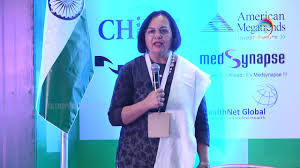Planet Mars has been fascinating the engineers all over the world for a long time. Researchers and scientists have been working to design simulated environments, rovers and safelights to explore the planet and its life possibilities.
To experience the living conditions and environment, a project called Poland Mars Analogue Simulation was designed.
The project aims to support real missions to Mars by giving researchers an opportunity to see what living and working on Mars will be like.
A team of engineers and researchers started experimenting with this project.
One among them was Aeronautics and Astronautics (AAE) graduate student Jennifer Pouplin. She has been an enthusiastic student studying astrodynamics and propulsion which made her a perfect fit for the experiment.
This was one of a kind of mission that is expected to help researchers potentially explore the planet.
Category: Industry
Industry
Five successful women Engineers
8th of March marks the International Woman’s Day to celebrate the woman who has achieved great heights all over the world. Here we have five successful woman engineers that made the country proud.
Priya Balasubramaniam, Vice President of iPhone operations, Apple
Serving as the Vice President of iPhone operations, Priya Balasubramaniam started her journey with Apple since the year 2001. The lady then made great success in the International supply chain team. She has played a prominent role to expand Apple product manufacturing.
Nandini Ramani, Vice President of Engineering, Twitter
Nandini Ramani plays a significant role as the Vice President of Engineering in the organization. She is also a major contributor to Twitter’s product strategy to promote the marketing activities, particularly, in India.
Anjali Joshi, Vice President of Product Management, Google
Anjali Joshi has been working with Google for ten years. She is well known for her versatility and her capability to handle any situation in the organization. She also has worked for Google’s cloud, and infrastructure along with news and finance departments.
Komal Mangtani, Head of Data Intelligence, Uber
Komal, before joining Uber has been working as the head of engineering at Box. At present, the lady is working as the head of engineering at Uber. Her team works to help Uber explore more market opportunities and analyze the overall business performance.
Aparna Ramani, Director of Engineering, Facebook
Aparna Ramani is currently working with Facebook as the Director of Engineering. She leads a team of professionals that deals with and processes real-time data and analysis. The team is a significant player in technology for Facebook’s Newsfeed.

What’s new in Ansys 19?
ANSYS 19 is also known as the Next Generation Pervasive Engineering Simulation technology. With the expanding digital world and growing data, companies are struggling with the pressure to improve performance to deliver high-quality products within a limited time. ANSYS 19, is designed to empower such engineers and professionals to contribute to the overall productivity. The enhanced capabilities of the technology aim to produce accurate results. Here are some of the many features that will support Pervasive Engineering Simulation.
3D Design
ANSYS 19 now introduced the new 3D design family of products.
- The package includes a real-time simulation environment that is developed to help engineers explore their designs and concepts.
- The CAD modeling capabilities of the ANSYS Discovery SpaceClaim now have new assembly configurations.
- Some of its supporting exploded views help engineers generate more efficient designs.
The technology helps to build upon topology optimization so that users can observe live progression to solve steps and make informed decisions.
Embedded Software
ANSYS 19 now has powerful capabilities to carry out tasks. These tasks include:
- Workflow integration
- Performance and usability
- A fully certified embedded software with a Human-Machine Interface (HMI) and
- Design capabilities
The technology is also supported by some dedicated solutions for automotive and avionics system and software. Added features here included capabilities for multi-rate application designs and enhanced HMI design capabilities that comply with ARINC 661 and that qualify for ISO 26262 and DO- 178C.
Electromagnetics
With the new technology, engineers can now design wireless, electrification and autonomous technology. The improved features of the technology include radar cross section analysis innovative electronic machine design, integrated electro-thermal analysis, and also a design kit to offer enhanced user experience with all the electromagnetic field simulation tools.
Semiconductors
To meet the growing demands of the next generation computing capabilities, which is not only automotive, but also is mobile, and delivers high performance computing through the advanced system. The technology th us demands products that are bigger, faster, and more complex. The simulation environment offered by ANSYS 19 delivers a platform that is more comprehensive, enabled for Big Data and capable of solving different design attributes such as thermal properties, power noise, performance and reliability across the spectrum accelerating your product success.
us demands products that are bigger, faster, and more complex. The simulation environment offered by ANSYS 19 delivers a platform that is more comprehensive, enabled for Big Data and capable of solving different design attributes such as thermal properties, power noise, performance and reliability across the spectrum accelerating your product success.
Systems
ANSYS 19 offers some of the most powerful capabilities in two crucial work areas:
- System simulation for battery management design and deployment
- Functional safety and analysis to use across all safety-critical industries
ANSYS 19 now has some enhanced features to help engineers easily model the complete design of a battery management system. Another add-on, ANSYS Simplorer helps the engineers to simulate and test the entire system after design and development. ANSYS 19 expands the functional safety analysis across all industries.

What’s New In 3DS MAX 2018
3ds Max 2018 brings several new features for creating visualizations. The 2018 version of the software replaces the metal ray by the Arnold renderer becoming the high-end global illumination render engine for creating 3D visualizations. The application now includes 3ds Max interactive, which is a real-time engine, based on the Autodesk Stingray. This new 3D to VR workflow is specially designed to provide the 3ds Max users a new way to create interactive and virtual reality (VR) experiences. The application has some amazing Modeling and Rendering features as described below:
3D Modeling
The PDF import features, as indicated by the design professionals will help them save a lot of money. The AutoCAD 2018 let you use the SHX text recognition tool to quickly convert the imported PDF geometry to text and Mtext objects. The improvised text and Mtext tools, in turn, lets you convert a combination of single and multi-line text objects into a single multi-line text object automatically predicting the formatting.
3D Rendering
The 3ds Max interactive offer access integrated tools to create VR visualizations without leaving your 3ds Max workspace. Some of its features include:
The MAXtoA plug-in integrated into 3ds Max gives the designer’s access to Arnold’s latest features.
The application can simulate real-life camera settings such as shutter speed, aperture, depth of field, exposure and some other options. The physical camera integrates framing the scene with exposure control and some other effects.
The new controls include a Create Panel, Standard menu, and Enhanced menu. The camera feature lets the designers use photorealistic physically-based rendering techniques.
The application also includes some improved active shade rendering. This feature gives the designers a preview rendering that helps the developers to see the effects of changing light or material in the designed scene.
This way the application gives the users more power and flexibility to create images and 3D models. The new 3ds Max also offers advanced user interface capabilities that enable users to access all the content in a single view. The application also has improvements in its pipeline tools integration. It helps designers create, share and update portable assets that are flexible, interconnected and responsive towards changes in the design data. You can run the new 3ds Max on modern HDPI monitors and laptops to get a better view of your designs.

New Techniques in Civil Engineering
Civil Engineering is evolving every day with the changing technology. Civil Engineers are now using innovations such as suspension systems to build bridges and using the GPS to plot new roads. As the technology brings new techniques, the civil engineering field continues to incorporate creative ways. Here, are four new techniques that are likely to change the construction process:
- Self- Healing Concrete
Cracks in the concrete is a common phenomenon. The cracks impair the durability of the concrete as they provide an easy path for the liquid and gas containing harmful substances to enter. To avoid this situation, researchers at the Bath University are working on a self-healing concrete that will contain micro-organisms inside microcapsules. According to the researchers, these micro-organisms will release limestone as water enters these splits to prevent the materials from breakage.
- Warm Bridging
Insulation material has become prominent in the construction industry. For this, Nasa developed material, Aerogel for cryogenic insulation. This material is considered as one of the most effective thermal insulation material. The technology is used to insulate studs, which can reportedly increase the overall wall R-value which is an industry measure of thermal resistance by more than 40 percent.
- Active Footfall
Researchers are now working out ways that can produce energy from footsteps. The technology used is known as Pavegen Floors. These are rubber tiles that have a spring-like action that generates energy when stepped on. This is a brilliant concept to harness the human energy power. The Pavegen tiles can benefit the most when installed in busy city areas to generate energy.
- Photovoltaic Glazing
Building structures that have the Building incorporated photovoltaic (BIPV) coating that is capable of producing their own power. The technology transforms the entire building envelope into a sun-powered board. An organization, known as Polysolar is providing photovoltaic glasses as the building materials. These Photovoltaic Glasses also do not cost much over the customary glass.
Apart from these, other technologies are also set to change the civil engineering practices such as Kinetic Roads, Cloud Collaboration, and Asset Mapping.




